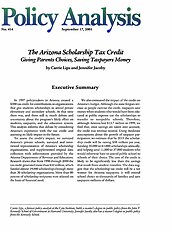In 1997 policymakers in Arizona created a $500 tax credit for contributions to organizations that give students scholarships to attend private elementary and secondary schools. At that time there was, and there still is, much debate and uncertainty about the program’s likely effect on students, taxpayers, and the education system. This analysis informs that debate by considering Arizona’s experience with the tax credit and assessing its likely impact in the future.
To assess the credit’s impact, we surveyed Arizona’s private schools, surveyed and interviewed representatives of Arizona’s scholarship organizations, and supplemented original data collection with information provided by the Arizona Departments of Revenue and Education. Research shows that from 1998 through 2000 the tax credit generated more than $32 million, which funded almost 19,000 scholarships through more than 30 scholarship organizations. More than 80 percent of scholarship recipients were selected on the basis of financial need.
We also estimated the impact of the credit on Arizona’s budget. Although the state forgoes revenue as people exercise the credit, taxpayers save money when students who would have been educated at public expense use the scholarships to transfer to nonpublic schools. Therefore, although Arizona lost $13.7 million in 1999, we find that, once savings are taken into account, the credit was revenue neutral. Using moderate assumptions about the growth of taxpayer participation, we estimate that by 2015 the scholarship credit will be raising $58 million per year, funding 35,000 to 61,000 scholarships annually, and helping send 11,000 to 37,000 students who would otherwise have to attend public school to schools of their choice. The cost of the credit is likely to be significantly less than the savings that result from student transfers. The data suggest that the scholarship tax credit will be a net winner for Arizona taxpayers; it will extend school choice to thousands of families and save taxpayers millions of dollars.
About the Authors

This work is licensed under a Creative Commons Attribution-NonCommercial-ShareAlike 4.0 International License.
